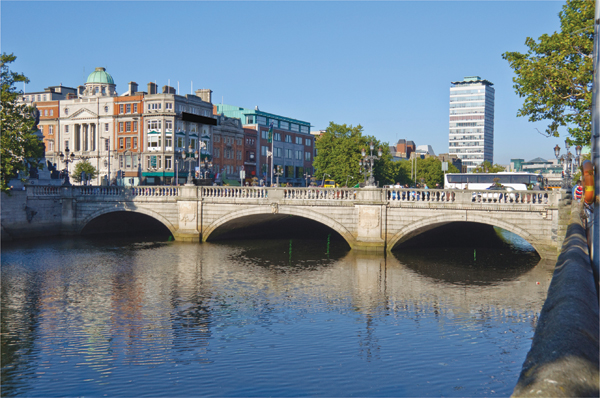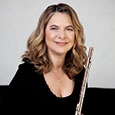
In 2005 I had the opportunity to move from the United States to teach at the Dublin Institute of Technology (DIT) in the Conservatory of Music and Drama. Besides being a third-level institution that serves full-time students in degree programs (undergraduate and postgraduate), there is also a Junior Conservatory for primary and secondary students. The school also accommodates part-time adult students. Originally, this teaching position was to be a short-term post as I was replacing a professor on sabbatical. However, on that person’s return, I was invited to remain on and in September 2012, I was appointed to the position of pro-rata part-time assistant lecturer in flute. I also had begun teaching in other private music schools. At the time, I never could have imagined how teaching in another country would change my life and how much I would gain from this experience.
Starting life in a new country presented many challenges. Fortunately, everyone speaks English although students learn Irish in schools. I was a bit reluctant to drive on the left side of the road and did not have a car initially so I relied on the buses and learned how to get around easily and efficiently. One aspect of living in Ireland that I have always found fascinating is how compact it is compared to the United States. One can literally drive or take a train to anywhere on the Island and get there within hours.
Teaching
When I first arrived in Dublin, I also had to get acquainted with a different system of teaching music. Living in Ireland has presented some wonderful challenges and has opened my eyes to many new and different methods of teaching and approaches to learning.
Having grown up in the States, I was a product of the marching band system. Although there are bands that perform at various functions and at athletic events in Ireland, marching bands are not as commonplace in the Republic of Ireland or in Europe in general, as they are in the United States. The primary level schools that have music focus on teaching singing or Irish music. (The tin whistle is a popular instrument, much like recorder in U.S. elementary schools, although recorders are also used.) At the secondary level there are choirs, orchestras, and traditional Irish music ensembles (and soloists) in the schools that have music programs.
Students in Ireland often start on the same types of flutes typically used in the States: closed-hole flutes with the off-set G key and C foot (straight or curved headjoint) and progress to the open-hole (either off-set or in-line G key). In Ireland however, the C-footjoint is more often the preferred option over the B-foot joint.
Many parents enroll their children in privately owned and operated music schools or schools run through government assistance. All of these charge tuition. At schools such as the DIT Conservatory of Music and Drama and the Royal Irish Academy of Music students audition to be admitted. This would not necessarily be the case in the privately run music schools. At the DIT, all Junior Conservatory and third-level students attend weekly instrumental lessons. The Junior Conservatory students attend theory class and perform in one of the numerous junior ensembles (Sinfonietta, Sinfonia, Prelude Winds, and Concert Band). There are also senior ensembles which could combine third level and junior conservatory students (Symphony Orchestra, Camerata, Wind Ensemble, Big Band, Early Music Ensemble and Irish Traditional Music Ensemble). The Conservatory has many vocal ensembles and instrumental chamber groups as well (at all levels).
As in the United States, the standard of playing and teaching varies significantly. However, the presence of a structured system of exams in Ireland provides students and teachers with valuable guidance and support. The exams offer students a tangible goal and helps them measure progress over time. The comments provided by the examiner also help to reiterate what teachers have said in lessons.
Ireland uses various systems for examining students in music. These examining bodies include, but are not limited to, the Royal Irish Academy of Music (RIAM, in Dublin), the Trinity Guildhall School of Music (Trinity College London), and the Associated Board of the Royal Schools of Music (ABRSM, in London). At the DIT Conservatory of Music and Drama, the Junior Conservatory exams are based on its syllabi and curriculum, and the Conservatory’s graded music examinations are currently being considered by the National Framework of Qualifications for recognition.
The students who participate in the practical exams work from a curriculum that provides a list of repertoire (solos/chamber, and studies) and a list of technical requirements (i.e. major/minor/chromatic scales, arpeggios, dominant and diminished seventh chords, scales in thirds, all to be played from memory) for each grade, levels one through eight. A sightreading and aural skills exam is also required and in some cases, theory, improvisation and musical knowledge. Students beyond grade eight may enroll in a certificate or diploma program and the testing requirements for these programs are set by each institution.
The method books and studies I use with students are often chosen based on the curriculum set out by the various examining boards and supplemented with other resources. Much of the repertoire that a student could use if going in for an exam would actually be published by the associated board. These resources are well organized with thoughtful selections for each grade level and may be purchased with or without a CD.
All students enrolled in secondary level schools are required to sit a Junior Certificate Exam at the end of their 3rd year, and if they continue, they take a Leaving Certificate Exam at the end of their 6th and final year. Both of these exams are overseen by the State Examinations Commission and require subjects such as English and math. Other subjects are optional, including music. In some cases, music may not even be offered in the student’s school, in which case the student may choose to study music as a subject outside of their school. Many institutions such as the DIT offer courses in Junior and Leaving Certificate Music. In both of these exams there are essential activities on which students are examined: performing skills, composing skills, and listening skills. Currently, the Junior Certificate Programme is in the process of being reformed.
I currently teach three days a week at the DIT and two days a week at Leeson Park School of Music. I also teach privately out of my studio at home on Saturdays. I do some flute ensemble coaching out of my studio as well.
Performing
When I first moved to Dublin, I played recitals in the DIT, at Newpark Music Centre in Blackrock (where I taught from 2005 until 2007), the John Field Room at the National Concert Hall and in other venues. I made many contacts in Dublin through a friend of mine and former conductor of the National Symphony Orchestra of Ireland as well as the Mississippi Symphony Orchestra, Colman Pearce. He is actually the reason that I heard of the job in Dublin.
In the summer of 2012, I formed a professional flute ensemble, Flute Éire. The group consists of piccolo, 4 C-flutes, alto flute, bass flute, and bodhran (traditional Irish drum). The debut performance was in November 2012 at St. Patrick’s College in Drumcondra. We have performed in various venues since then, including at the 2013 National Flute Convention in New Orleans. We have premiered two works by Irish composers John Buckley and Glen Austin. Our focus has mainly been on repertoire by Irish composers.
When I arrived in Dublin, I was eager to learn about traditional Irish music. I started going to my local pub and listening to music. I began learning some tunes (slow airs, jigs, reels and some hornpipes). Not being shy, I asked to join in playing with the group and soon began going regularly. I picked up tunes by ear and also found printed music to learn from although it is often not the same as what you hear played because people perform pieces with many variations and different ornamentation. I play Irish music on the silver flute. (There are some traditional Irish flute players who do play on the silver flute and not the wooden flute.)
I met my now husband through playing traditional music because he plays guitar, banjo, bouzouki, and mandolin. He has a wealth of knowledgeabout traditional Irish music.
Many of the musicians who perform in the pubs play several times a week. There is typically a group of hired musicians that run the session, and other musicians can join in. Some sessions are very open and friendly, and other people can play along or have a solo. Very often there are regulars who have a signature song or tunes that they perform. I have my own favorites, including Inisheer, Sligo Maid/Star of Munster, and some O’Carolan tunes.
Ornamentation is extremely important in Irish music. The grace note is very common but is not used in the same way as in the classical style. Grace notes (from above and below – called cutting) are typically used where two notes in a grouping are the same, as between repeated note passages. Other types of ornaments used are rolling, craning, and sliding a note.
Life is full of surprises that lead us on to the next challenge. Being a teacher has always been my calling, but I never expected to be called to another country. It has been one of the most gratifying experiences for me and one that I would never change.
For more information on the DIT Conservatory of Music and Drama see the website: www.dit.ie/conservatory.
Marking Scheme by Program
Trinity Guildhall:
All practical graded exams are marked out of 100 possible points. If students receive a mark ranging from 87 to 100 they would have the title of Distinction. A mark ranging from 75 to 86 would be a Merit, from 60 to 74 would be a Pass, from 45-59 would be a Below Pass 1, and 0 to 44 would be a Below Pass 2.
First piece (with accompaniment): Maximum 22 points
Second piece (with accompaniment): Maximum 22 points
Third piece (unaccomp. study or solo): Maximum 22 points
Technical Work: Maximum 14 points
Supporting Test 1: Maximum 10 points
Supporting Test 2: Maximum 10 points
*Supporting Tests would be chosen from the following: Aural Skills, Sightreading, Improvisation, and Musical Knowledge
www.trinitycollege.co.uk
Associate Board of the Royal Schools of Music
All practical graded exams are marked out of a possible 150 points. The required points to Pass would be 100, to receive a Merit would be 120, and to receive a Distinction would be 130.
First Piece (with accompaniment): Maximum 30 points
Second Piece (with accompaniment): Maximum 30 points
Third Piece (unaccomp. study or solo): Maximum 30 points
Technical Work: Maximum 21 points
Sightreading: Maximum 21 points
Aural Tests: Maximum 18 points
www.abrsm.org/exams
The Royal Irish Academy of Music
All practical graded exams are marked out of a possible 100 points. A candidate who receives 90% or over would be awarded a Distinction, 80% to 89% would be awarded an Honours, 70% to 79% would be awarded a Merit, and 60% to 69% would be awarded a Pass.
First Piece (with accompaniment): Maximum 20 points
Second Piece (with accompaniment): Maximum 20 points
Third Piece (unaccomp. study or solo): Maximum 20 points
Technical Work: Maximum 15 points
Sight-reading: Maximum 10 points
Aural Tests (up to grade V): Maximum 10 points
Aural Tests (grades VI-VIII): Maximum 15 points (no theory test required)
Theory Tests: Maximum 5 points
www.riam.ie






